The iPhone 7 and iPhone 7 Plus Review: Iterating on a Flagship
by Joshua Ho & Brandon Chester on October 10, 2016 8:00 AM EST- Posted in
- Smartphones
- Apple
- Mobile
- iOS
- iOS 10
- iPhone 7
- iPhone 7 Plus
Display Analysis
Section by Brandon Chester
It's hard to deny the importance of having a great smartphone display. Almost every interaction done with a smartphone involves the display, and we've seen the quality of smartphone displays improve greatly with each year. When looking at the iPhone 7 and 7 Plus at a high level, they appear to use the same displays as the previous two generations of iPhones. The iPhone 7 uses a 1334x750 IPS LCD panel with a pixel density of 326ppi, while the iPhone 7 Plus uses a 1920x1080 IPS LCD panel with a pixel density of 401ppi. However, when you take a deeper look, it's clear that these are not the same displays as those in the iPhone 6 and 6s.
The most obvious improvement that Apple advertises is a substantial increase in peak brightness. Previously both models of the iPhone were rated at 500 nits, while the iPhone 7 and 7 Plus are rated at 625 nits, a 25% increase. Both displays now support the Display P3 color space as well, which makes them the first wide gamut iPhones, and with the color management built into iOS they are also the first smartphones to correctly make the transition to a wider gamut than sRGB. I covered this topics in my review of the 9.7" iPad Pro which was the first wide gamut iOS device, and with the iPhones moving to wide gamut alongside the iPads and iMacs it looks like Apple wants to have it standardized across their entire product line very soon.

iPhone 7 Plus Display Assembly (Image Courtesy iFixit)
Both the improved brightness and wide gamut trace back to a change in the display's LED backlight. A standard blue LED with a yellow phosphor cannot produce the intense green and red wavelengths needed to cover a gamut wider than sRGB, and Apple has most likely used the same system of blue LEDs with green and red phosphors from the iMacs to expand the iPhone's color gamut, with the new LEDs also allowing for a higher peak brightness.
While the color gamut and brightness levels of the displays on this year's iPhones have changed, the resolutions have not. In the case of the iPhone 7, I think this presents an issue. There's something to be said about inexpensive Android phones shipping with sharper displays than Apple's flagship $649 smartphone. Of course, resolution is only one of the metrics that are applicable to a display, but it's an important one. I'll touch on the issue of resolution again later, but for now I'd like to get into the accuracy analysis of the displays on the iPhone 7 and 7 Plus.
Our display testing workflow has changed slightly for this review, with the addition of the Display P3 saturation test. I've used this once before in the iPad Pro 9.7" review, and as more devices adopt the P3 gamut it will continue to show up. In the interest of openness, I also thought it would be worth mentioning that the measurements for these tests were performed by both Josh and I. Josh measured the iPhone 7 Plus using the review unit that we received, and the iPhone 7 results are actually from a unit that I purchased myself in order to assist with testing and analysis for this review.
As always, measurements are performed with an X-Rite i1Pro 2 spectrophotometer, with the exception of black levels which are measured with an i1Display Pro colorimeter to achieve the most accurate results possible in an area where the i1Pro 2 can be somewhat unreliable. Data is collected and examined using SpectraCal's CalMAN software.


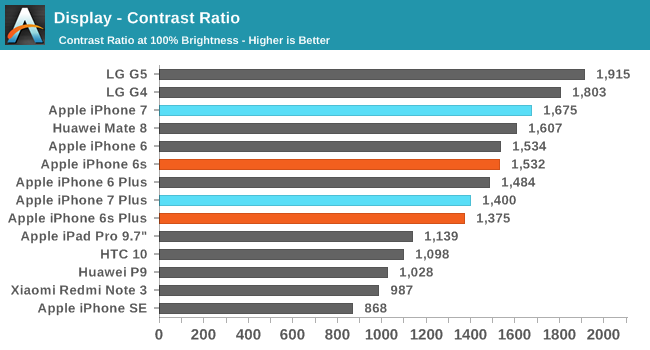
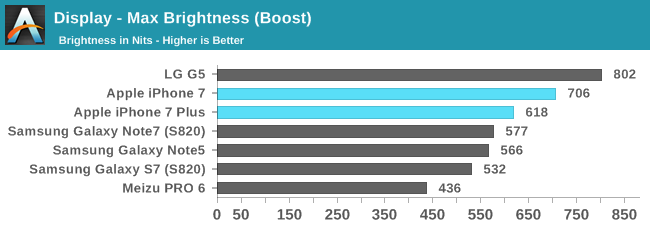
Apple advertises that the iPhone 7 and 7 Plus both have a typical brightness of 625 nits. From one point of view, they've oversold their display in this regard. From another point of view, they've actually undersold it. On the iPhone 7 the maximum brightness by setting the slider manually is just over 600 nits. This isn't that far off of Apple's claimed 625, although falling short by 4% is not insignificant even if it's not a huge gap. The 7 Plus doesn't fare as well, coming in at just over 550 nits, around twelve percent lower than what Apple advertises. At this point one would assume that the displays don't get as bright as claimed, but there's actually something else going on.
Boosting brightness for short period of time when auto brightness is enabled is not a new feature. OLED displays have done it for some time, and modern LCDs like those on LG's flagship smartphones can do it as well. It turns out that Apple has added the same sort of boost mode on the iPhone 7 and 7 Plus. When the phone's brightness is set to automatic and there's bright ambient lighting the display will push above the maximum brightness in manual mode. On the iPhone 7 Plus it reaches 618 nits, which is right around Apple's claimed 625 nits. The iPhone 7 goes above and beyond, hitting 706 nits in the boost mode, which is 13% higher than what is advertised.
As for black levels, they're in line with the previous generation iPhones, but the fact that the maximum brightness has increased significantly while black levels remain constant means that the contrast ratio has increased. In the case of the 7 Plus the increase isn't very large since the 6s Plus unit we reviewed actually exceeded Apple's rated contrast of 1300:1. For the iPhone 7 the increase is more significant, even though our 6s also exceeded Apple's rating of 1400:1 for the 4.7" iPhone. While neither phone's black levels or contrast are at the level of an AMOLED display, they do quite well among LCDs.
The displays on the iPhone 7 and 7 Plus offer an appreciable improvement in brightness and contrast compared to their predecessors. It's worth noting that previous iPhones had a considerable amount of backlight variance, with Apple rating them for a typical brightness of 500 nits even though some units actually reached as high as 600 nits. Even when compared against the best iPhone 6s and 6s Plus units, the iPhone 7 and 7 Plus will have improved usability outdoors, and in any other circumstance where there's harsh ambient lighting. I do feel somewhat uneasy about Apple advertising the boost brightness as their typical peak brightness, as in the case of the 7 Plus the manual brightness is significantly lower. However, I would imagine that most users keep auto brightness enabled, so while I don't necessarily agree with it from a marketing standpoint, it's probably true that the marketing reflects what most users will experience.

Moving on from brightness and black levels, we now come to our standard greyscale accuracy test. This test measures 21 points from 0 to 100% white. As you can see in the image above, the performance of both the iPhone 7 and 7 Plus in this test is remarkable. The RGB balance for each shade is very stable, with only the slightest shift toward blue, leading to a CCT average of 6608K. Like the iPad Pro 9.7", this much closer to sRGB's target white point than older iOS devices, likely owing to the new LED backlight not providing significantly improved efficiency when the display is skewed toward blue. The gamma is quite straight, with only some minor variation past 80% white. Even with that, no error value for an individual shade of grey hits three, and many are close to one, making them essentially indistinguishable from the reference shade.
Receiving a unit with this level of accuracy could lead one to suspect that it's an extraordinarily good sample. However, as I mentioned before, the iPhone 7 I measured was one that I bought on my own, and it would be quite a coincidence if both review units and a purchased unit had the same incredibly high accuracy if that was not typical of all units in general.
With this level of accuracy, it is almost certain that Apple is doing individual calibration of each iPhone 7 display. This is actually not hard to imagine, given that the iPad Pro 9.7" was advertised as being individually calibrated, and engineers at this year's WWDC also claimed that individual calibration is now standard across Apple's product line. This makes sense when you consider the implications of wide gamut and color management. If you apply a single profile to a batch of units, it will not perfectly represent the output characteristics of each display. That would lead to errors when applying a transform to render sRGB content properly on the wide gamut display, as you would be translating values based on output values that were only close to those of the actual display. I actually ran into this exact issue in my recent review of Lenovo's X1 Yoga OLED, which has a wide gamut display without per-unit calibration. To properly pull off wide color and color management you need to individually calibrate each display, and the incredibly high accuracy is just a bonus.
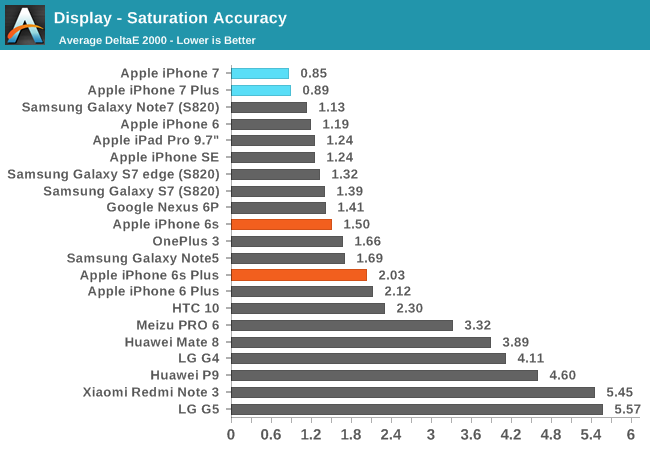
The next test examines the accuracy of primary and secondary colors on a display. Measurements for each color are done in 20% steps from 0 to 100% saturation. This first saturation test targets the sRGB color gamut, with a gamma target of 2.2 and a white point of D65. In this case I really don't have anything to say about the iPhone 7 and 7 Plus because they are the most accurate displays on record in this test. For all but three or four colors the human eye would not be able to distinguish the colors on the display from the true reference shade, even if they were put side by side.
The interesting thing about this test is that the accuracy is guaranteed to be high when a vendor ships an individually calibrated wide gamut display on a color managed OS. When individually calibrating a display, your profile is essentially a perfect characterization of the display's output. This means that even if your standards for calibration are relatively relaxed, such as targeting a DeltaE of 3, your sRGB accuracy won't be affected because the transform performed to converted sRGB content to the display's gamut will take into account any differences between the display's output and the true values of the gamut it targets. The two limitations of this are the accuracy of your profiling device when calibrating, and the bit depth of the display, which forces you to map onto a set of values that is likely not as precise as the optimal output value unless you have some theoretical 16bit per channel display. As you can see from the results, neither of these are a truly significant issue.
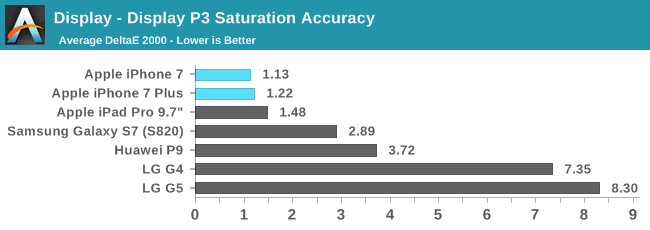
This saturation test uses the same methodology as the previous one, but it targets the DCI-P3 color gamut with a gamma of 2.2 and a white point of D65. These values deviate from the DCI-P3 standard for digital cinema, but a gamma of 2.2 is most appropriate for a mobile device's viewing conditions, and D65 is the standard white point for all gamuts that users will be used to, with the 2.6 gamma and non-standard "D63" white point for DCI-P3 being chosen for the viewing conditions of a dark theatre. Apple describes this adaptation of the DCI-P3 standard Display P3, and it appears to be what other vendors have also settled on in order to expand on the tonal range of the sRGB color space without changing the white point or gamma.
In this test the iPhone 7 and 7 Plus lead the pack once again. There are some minor errors in low green saturations, but neither are truly significant. The 9.7" iPad Pro is right behind them, and the best comparable Android device is the Galaxy S7 with a DeltaE of 2.89. It's worth mentioning that Samsung doesn't actually advertise P3 gamut support, so the fact that their wide gamut mode is close is impressive and suggests that they had it in mind but didn't attempt to provide incredibly high levels of accuracy in that mode. Meanwhile, LG explicitly advertises DCI-P3 gamut support, but regardless of which gamma you use it fails miserably because the green and red primaries aren't even close to the DCI-P3 primaries.

Last is the GretagMacbeth ColorChecker test. This test examines the accuracy of 24 colors that are commonly found in nature, which makes it a good metric for how accurately a display can render color mixtures that have red, green, and blue color components. Like all the other tests, the iPhone 7 and 7 Plus have industry-leading accuracy. Most colors are so close to the reference shade that it's not possible to tell the difference, and the largest errors in are the bright shades of grey which are still below the general target of three, but not quite as low as the rest of the patterns.
I find it very difficult to come to a single verdict on the iPhone 7's display. In the case of the 7 Plus I don't have any hesitation when describing it as a great mobile display, and certainly the most accurate on record. Whether or not it's the best mobile display is debatable, as Samsung provides serious competition with their AMOLED displays which benefit from perfect blacks. However, I think AMOLED's color shifting off angle puts it at a disadvantage, and Samsung is in the unfortunate situation of having to deal with Android not having any form of color management, which means that the wide color modes that their AMOLED displays have available are not truly useful. Apple's control over the hardware and software stack allows them to provide tools for creating wide color content without compromising the visual integrity of existing sRGB content, and that makes the display decidedly more future-proof.
All of the above statements apply to the iPhone 7's display, except for the one about being future-proof. That statement is true as far as color is concerned, but it's definitely not true of the display's sharpness. Apple's smartphones have remained at a pixel density of 326ppi for over six years. At the time, that pixel density was much greater than anything the competition could put out, and it wasn't matched until around eighteen months after release. Nowadays, nearly every Android device has moved far past Apple in this regard, including mid-range devices that cost $200.
The resolution of the iPhone 6 seemed reasonable at a time where technologies like Auto Layout had not been embraced by the development community, and existing bitmaps were designed for a 2x rendering scale. With the iPhone 6s it seemed suspect, but the phone brought many other substantial upgrades that made it possible to overlook the relatively low-resolution display. With the iPhone 7 releasing in late 2016, I really don't know what Apple's excuse is. It's entirely possible that they would not have been able to meet their brightness target if they moved the 4.7" iPhone to a higher resolution, but I am confident that it would not have posed an issue for the move to wide gamut, which is just related to the spectral output of the LED backlight. HTC showed that a 4.7" 1080p panel was possible back in early 2013 with the One M7, and anyone who owned it can attest to how much sharper the rendering is than on Apple's 1334x750 displays.
The 4.7" iPhone 7's display is definitely an improvement over its predecessor. The significant increase to brightness, and subsequent increase to contrast are both appreciated. The move to wide color is setting the foundation for future wide color content, as well as existing content that will be shot on the iPhone 7's own camera. The improved calibration makes it the most accurate smartphone display on the market. Even so, I think the area that really needed improvement was the sharpness of the display, and that remains the same as it was in 2010.


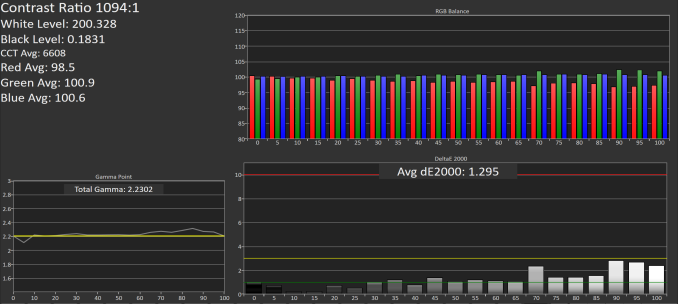
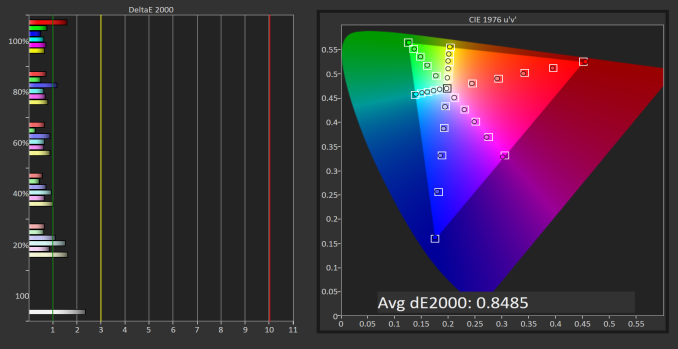
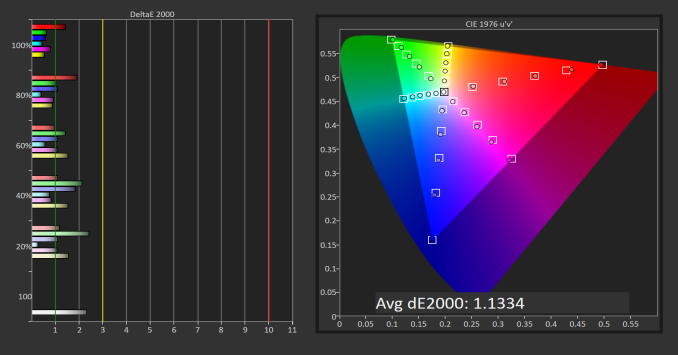
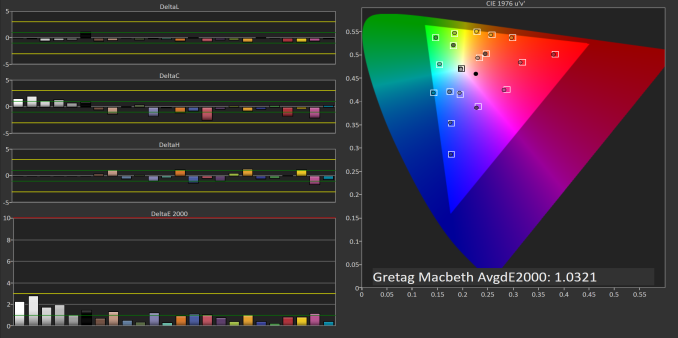








377 Comments
View All Comments
zodiacfml - Thursday, October 13, 2016 - link
Yep. The Google Pixel(s) is claimed to shoot HDR almost instantaneously which is useful to me. I don't use it if I will need flash photography on my Nexus 5. HDR is a must in most cases. White Balance is hard to fault after the HDR process.techconc - Thursday, October 13, 2016 - link
Well said. I suppose if people simply use their phones for texting, they wouldn't understand why more power is needed. I'm looking at what the iPhone 7 plus is doing with showing real time previews of fake bokeh on images in portrait mode. It's absolutely amazing what they are accomplishing on a phone these days.For that matter, try playing a game like World of Tanks Blitz on the Nexus 5X. Trust me, iPhone owners like users like them. It helps them pad their stats with more kills, etc. Honest, this "why do we need more performance" argument is pretty comical.
zodiacfml - Thursday, October 13, 2016 - link
You have a point there and I still use a Nexus 5 everyday. It is plenty fast 95% of the time and only lags during app updates which I don't mind. It is perfectly usable while doing its tasks of downloading and installing updates.I'm itching for new hardware though as the Nexus 5 could use an AMOLED display, larger battery, and external storage. A new SoC can help though with better battery life at idle or average tasks.
Yeah, I guess you are right about the 820. The 820 is impressive if found on devices around the price range of the One Plus 3. Androids with costs near an iPhone 7 is not good value.
omeryounos - Wednesday, October 12, 2016 - link
@Anadtech, really clever review. You guys totally omitted Galaxy S7 Edge (with Exynos 8890) from system performance & battery test to showcase Apple's greatest innovation ever. Especially your comments in Battery life section stating that look how much better it is from Galaxy S7 (Exynos) & omit any results from Galaxy S7 Edge (Exynos), knowingly that it will beat both iPhone 7 & Plus hands down in all battery test by hours. We (the readers) expect more balanced reviews from this site especially when it is coming weeks later than most mobile sites.BenSkywalker - Wednesday, October 12, 2016 - link
I'm curious why you didn't dive far more into Apple's utterly staggering breakthrough in LCD technology-"However, I think AMOLED's color shifting off angle puts it at a disadvantage"
Out of the hundreds of in depth instrumented tests I have witnessed and comparing hundreds of displays never have I seen a single LCD that was capable of besting *any* OLED in off angle performance- actually given the physics involved and how the displays are built, this is widely considered impossible. Given how extremely simple this is to test, I'm a bit confused as to why you haven't documented this industry changing technology and exactly what level of off angle performance improvement it shows over every other LCD ever made.
I saw the comments about off angle OLED colors being an issue in the laptop review posted a short while ago, figured you must have had a defective unit(the *only* explanation)- now you are saying this iPhone7 display bests all AMOLEDs at off angle color accuracy- really hoping you can post your measured results with exactly what degree of variation you are seeing.
Displaymate must have tested something wrong, they are still showing the iPhone7 with a catastrophic 55% drop off for brightness with some color shifting too at a mere thirty degrees, two of the photos on the front page of your review I think are also mislabeled, they say they are iPhone7 but they are showing abhorrent off angle viewing- they must be of some other, non Apple, phone.
JoshHo - Wednesday, October 12, 2016 - link
I think it goes without saying that LCD will have greater off-angle contrast reduction than AMOLED, but for color accuracy you can look at the dE2000 formula and see that changes in hue are more significant than changes in luminance in human perception of color. You can also see DisplayMate's results to see that the iPhone 7 has about a third of the color shift of the Note7's display with changes in viewing angle which is due in part to the subpixel arrangement:http://www.displaymate.com/iPhone7_ShootOut_1.htm
http://www.displaymate.com/Galaxy_Note7_ShootOut_1...
If you have any other questions or concerns please feel free to contact me by email as I don't have the time to sift through hundreds of comments searching for responses. My email is josh@anandtech.com.
philehidiot - Wednesday, October 12, 2016 - link
What I would like to see is a more in depth look at the sound quality. Not through the speakers but through headphones. The reason for this is that I attached a pair of monitoring headphones to my HTC M9 and found the top end to be incredibly harsh and distorted but when plugging those same headphones into my tablet (Kindle Fire 7 HDx) the sound was far better and there was no distortion. I would guess Apple would have better sound than the competition but a paragraph on wired headphone performance would be good and might well push more manufacturers to improve in this area. Interestingly, the Dolby "enhancements" make cheap headphones sound a load better but make decent monitoring headphones sound far worse - I assume this is because the compression applied to bring the sound into the limited dynamic range of the cheaper headphones actually helps but on the more expensive ones which can reproduce the full dynamic range of the recording it just effectively narrows it. Someone please correct me if I'm talking bollocks.UtilityMax - Wednesday, October 12, 2016 - link
For me, the iPhones do not exist, because I own a large media collection and I can't upload any of it to the iPhone without going through slow and buggy iTunes. On top of that, the iPhones do not exist for me after the 7 release after they deleted headphone jack. I own several audiophile grade but still very affordable headphone, and not of them can be used with it. I'd have to replace each one of them with a different set that costs something 2-3 times more and the benefits of doing that are pretty much dubious.So yes, in my world view, I would take a Moto G over the iPhone any day.
blackcrayon - Wednesday, October 12, 2016 - link
Sounds like you don't understand iPhones or iOS if you think you *HAVE* to use iTunes to put media on it... Hell, you don't even seem to know that they come with a headphone jack adapter for all of your "audiophile grade" headphones...UtilityMax - Wednesday, October 12, 2016 - link
I understand the iOS and issues very well. There are ways to bypass iTunes, then they still suck big time. As for the headphone jack, you can keep the headphone adapter to yourself. I am not carrying it, when it is about million times more convenient not to have to use it.